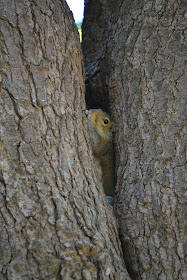 |
| Some trees did succumb to Irene's winds, but not as many as I expected. |
I think the Black-and-white Warbler might be one of my favorite warblers -- they're so pretty and distinctive, and I meet them quite often in these woods. These birds can even creep vertically and upside-down on branches and trunks, almost like a nuthatch. And I just can't get enough of those dramatic stripes. This individual is either a female or an immature male, as adult males have even more stripes, if you can believe it. This really is quite a lot of stripes already.
I can't resist one more picture of this bird -- how cool are those feathers under its tail (properly called "undertail coverts")?
This medium-sized caterpillar hitched a ride on my pant leg for a little while before I noticed that it was there and relocated it to a more appropriate stick:
You'd think this would be an easy creature to identify, with those fancy jewel-like orange and white spots clustered on its back, but it actually took input from multiple people on BugGuide.net to come up with an identification. As it turns out, it's the caterpillar of an Interrupted Dagger (Acronicta interrupta), a rather plain-looking grayish moth with subtle markings -- the caterpillar sure is something to look at, though!
On my way out of the woods, the last thing I saw was this Gray Squirrel keeping watch from his (or her) post in a narrow tree crevice:
I see you, little guy! Good luck on your sentry duties, and be safe!




















































